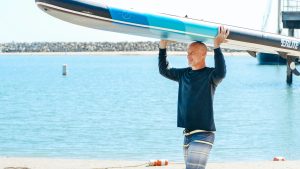Inflatable paddle boards come in a wide range of qualities and prices especially since they are made from various materials with different manufacturing costs.
Still, all inflatable kayaks are essentially an air bladder made of drop stitch fabric protected in some form of air-tight and puncture-resistant coating.
A drop stitch fabric consists of two fabric sheets joined together by thousands of 5-6 inch long threads. The edges of the fabric sheets are joined with an air-tight material, which allows you to inflate it. But unlike other inflatable objects which curve out when blown up, the threads binding the two fabric sheets prevent an inflatable paddle board from curving out and therefore maintain its board-like shape.
The inflatable core of a SUP is typically made of a single layer, fusion, or dual-layer construction. The rails (the edges of the paddle boards) are made with single or dual-layer rail bands—in some cases, manufacturers even provide additional reinforcement strips to improve the board’s rigidity.

What are Inflatable Paddle Boards Made Of?
There are two parts of an inflatable paddle board: the core and the rail (edges), while there are three types of inflatable paddle board constructions. Let’s go through each of them.
Inflatable Paddle Board Core Constructions
The ‘core’ of an inflatable paddle board is the middle section which contains air and plays the major task of keeping you afloat. The three types of constructions for the core of an inflatable paddle board are:
Single Layer Construction
In a single-layered inflatable paddle board, the drop stitch typically has a pair of single-ply sheets at the top and bottom with a layer of flexible PVC coating.
Most boards under $700 have a single-layer construction, which may not have the most robust build quality. Therefore, you’ll often end with low-end and middle-end paddle boards that are around 6-inches thick—which is not the optimal thickness for performance, but is necessary to make up for the lack of rigidity.
Single-layer paddle boards feel more rubbery and more susceptible to puncture. The notoriety of single-layer materials usually made people avoid them, which is why many manufacturers often slap on a more marketable name for their materials.
Uninformed buyers might fall easily into the marketing pitfall, but since there is no universally accepted naming for paddle board materials, there’s no way to avoid it except for educating yourself.
Fusion Construction
This type of construction has the perfect balance between weight, rigidity, and cost-efficiency.
In a fusion construction, the top and bottom sheets of fabric consist of permanently bonded layers. There’s also a layer of PVC coating on top of the two-ply sheets of fabric.
In other words, fusion construction paddle boards are highly durable and can withstand consistent wear and tear for an extended period. Compared to single-layer boards, fusion paddle boards are significantly more rigid and resistant to punctures.
Fusion construction paddle boards typically start at around $900. Since the materials have more rigid construction, manufacturers can make the board a little thinner at approximately 5″ thick—which is more natural and beneficial for the board’s performance on the water.
Dual-Layer Construction
Dual-layer construction is the epitome of paddle board quality and the best option for those who aren’t concerned with the cost. This paddle board construction involves more material and requires more labor to make, which obviously results in its top-notch quality.
A dual-layer paddle board starts with a typical single-layer construction, but with everything protected by an additional coat of PVC-coated fabric. Inflatable SUPs with dual-layer construction are superior in quality, performance, and durability.
The additional PVC-coated fabrics provide extra puncture and leak protection to the paddle boards. However, the extra layers also add 3-4 pounds of weight, making the final price significantly more expensive than the other two construction models.
However, all those extra materials and build quality will translate into an inflatable paddle board that feels very well-balanced and steady on the water.

Inflatable Paddle Board Rail Constructions
The rail of inflatable paddle boards is the outer rim of an inflatable paddle board that wraps around the core to provide an additional layer of protection. The rail of an inflatable paddle board joins the top and bottom sheets of the board with reinforced and air-tight PVC-coated strips.
The materials used to join the two halves of the paddle boards significantly impact the board’s overall stability, rigidity, and performance while on the water.
Just like the core of an inflatable paddle board, there are also different types of paddle board rail constructions. Let’s go over some of the popular ones.
Single Rail Band
This type of paddle board rail is made of a single layer of PVC-coated fabric to close off the core of the board. It is the cheapest way to do the rails of an inflatable paddle board, but it’s also prone to punctures and leaks.
Inexpensive paddle boards often have this type of rail construction, which makes them very vulnerable when you’re paddling near corals or rivers with sharp rocks. However, most manufacturers are aware of these risks and often protect the rails of their paddle boards with a 1-inch wide strip of PVC.
If you’re wondering how long do paddle boards last, check out this article from SupBoardGuide.com for more information and tips to increase the longevity of your inflatable paddle boards.
Dual Rail Band
Paddle boards with dual rail bands have an additional layer that contributes to the board’s overall rigidity and stability. In this rail construction, a smaller inner band combines the containment layer with an additional larger band bonded on top of it.
Many manufacturers also opt to add a layer of low-stretch material, improving the board’s rigidity and providing an extra layer of puncture protection.
Heat-Welded Rail
Heat-welding is an experimental method that many manufacturers have been using to fuse the rail layers with heat as opposed to using adhesive layers. Joining the layers with heat has the potential to be more cost-efficient compared to using adhesive layers.

Conclusion
There are various construction types that determine the quality and overall rigidity of an inflatable paddle board. When it comes to inflatable paddle boards, the price can often tell the kind of quality you’ll get. If you’re planning to be using your paddle board for an extended period, it’s best to invest more in the higher-end models to get the best of your money.
We hope this article answers the ever-burning question, “what are inflatable paddle boards made of?”
Related Posts
- Best Inflatable Paddle Boards Under $400
Inflatable paddle boards can come in a wide range of prices, and today we're going…
- Finding the Best Inflatable SUP For Beginners
Finding the best inflatable SUP for beginners can be challenging due to the overwhelming amount…
- 10 Things to Consider Before Buying an Inflatable SUP
If you're thinking about getting an inflatable stand-up paddle board, and you're having a hard…
